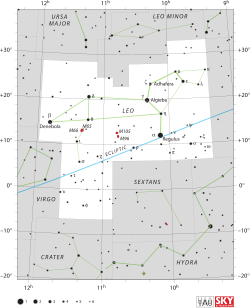Xi Leonis
| Xi Leonis (ξ) | |
 | |
| Observationsdata Epok: J2000.0 | |
|---|---|
| Stjärnbild | Lejonet |
| Rektascension | 09t 31m 56,73886s[1] |
| Deklination | 11° 17′ 59,3933″[1] |
| Skenbar magnitud () | 5,1437[2] |
| Stjärntyp | |
| Spektraltyp | K0 III[3] |
| U–B | +0,88[4] |
| B–V | +1,03[4] |
| Variabeltyp | Misstänkt |
| Astrometri | |
| Radialhastighet () | 34,85 ± 0,26[2] km/s |
| Egenrörelse (µ) | RA: -89,98[1] mas/år Dek.: -81,85[1] mas/år |
| Parallax () | 15,13 ± 0,31[1] |
| Avstånd | 216 ± 4 lå (66 ± 1 pc) |
| Absolut magnitud () | 0,663[5] |
| Detaljer | |
| Radie | 12[6] R☉ |
| Luminositet | 60[6] L☉ |
| Temperatur | 4 688[6] K |
| Metallicitet | -0,17[6] |
| Vinkelhastighet | 0,0[6] km/s |
| Ålder | 3,89 ± 2,03[5] miljarder år |
| Andra beteckningar | |
| ξ Leo , 5 Leonis , BD + 11° 2053, HD 82395, HIP 46771, HR 3782, SAO 98627.[7] | |
Xi Leonis (ξ Leonis , förkortat Xi Leo, ξ Leo) som är stjärnans Bayerbeteckning, är en ensam stjärna belägen i den sydvästra delen av stjärnbilden Lejonet. Den har en skenbar magnitud på 5,14[2] och är svagt synlig för blotta ögat. Baserat på parallaxmätning inom Hipparcosuppdraget på ca 15,1 mas,[1] beräknas den befinna sig på ett avstånd av ca 216 ljusår (66 parsek) från solen.
Egenskaper[redigera | redigera wikitext]
Xi Leonis är en orange till röd jättestjärna av spektralklass K0 III[3]. Den har en radie som har expanderat till 12 gånger solens radie[6]. Den utsänder från dess fotosfär 60[6] gånger mer energi än solen vid en effektiv temperatur på 4 688 K.[6] I Combined General Catalogue of Variable Stars anges den som en misstänkt variabel stjärna med en maximal skenbar magnitud på 4,97.[8]
Källor[redigera | redigera wikitext]
- Den här artikeln är helt eller delvis baserad på material från engelskspråkiga Wikipedia, tidigare version.
Referenser[redigera | redigera wikitext]
- ^ [a b c d e f] van Leeuwen, F. (2007), "Validation of the new Hipparcos reduction", Astronomy and Astrophysics, 474 (2): 653–664, Bibcode:2007A&A...474..653V, arXiv:0708.1752 Freely accessible, doi:10.1051/0004-6361:20078357.
- ^ [a b c] Famaey, B.; et al. (2005), "Local kinematics of K and M giants from CORAVEL/Hipparcos/Tycho-2 data. Revisiting the concept of superclusters", Astronomy and Astrophysics, 430: 165–186, Bibcode:2005A&A...430..165F, arXiv:astro-ph/0409579 Freely accessible, doi:10.1051/0004-6361:20041272.
- ^ [a b] Eggen, O. J. (1962), "Space-velocity vectors for 3483 stars with proper motion and radial velocity", Royal Observatory Bulletin, 51, Bibcode:1962RGOB...51...79E.
- ^ [a b] Mermilliod, J.-C. (1986), Compilation of Eggen's UBV data, transformed to UBV (unpublished), SIMBAD, Bibcode:1986EgUBV........0M.
- ^ [a b] Soubiran, C.; et al. (2008), "Vertical distribution of Galactic disk stars. IV. AMR and AVR from clump giants", Astronomy and Astrophysics, 480 (1): 91–101, Bibcode:2008A&A...480...91S, arXiv:0712.1370 Freely accessible, doi:10.1051/0004-6361:20078788.
- ^ [a b c d e f g h] Massarotti, Alessandro; et al. (January 2008), "Rotational and radial velocities for a sample of 761 HIPPARCOS giants and the role of binarity", The Astronomical Journal, 135 (1): 209–231, Bibcode:2008AJ....135..209M, doi:10.1088/0004-6256/135/1/209.
- ^ "ksi Leo -- Variable Star", SIMBAD Astronomical Database, Centre de Données astronomiques de Strasbourg, hämtad 2016-09-29.
- ^ Samus, N. N.; Durlevich, O. V.; et al. (2007), Combined General Catalogue of Variable Stars (GCVS4.2), retrieved 2016-09-30. VizieR On-line Data Catalog: B/gcvs.





